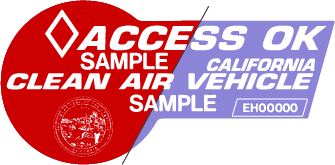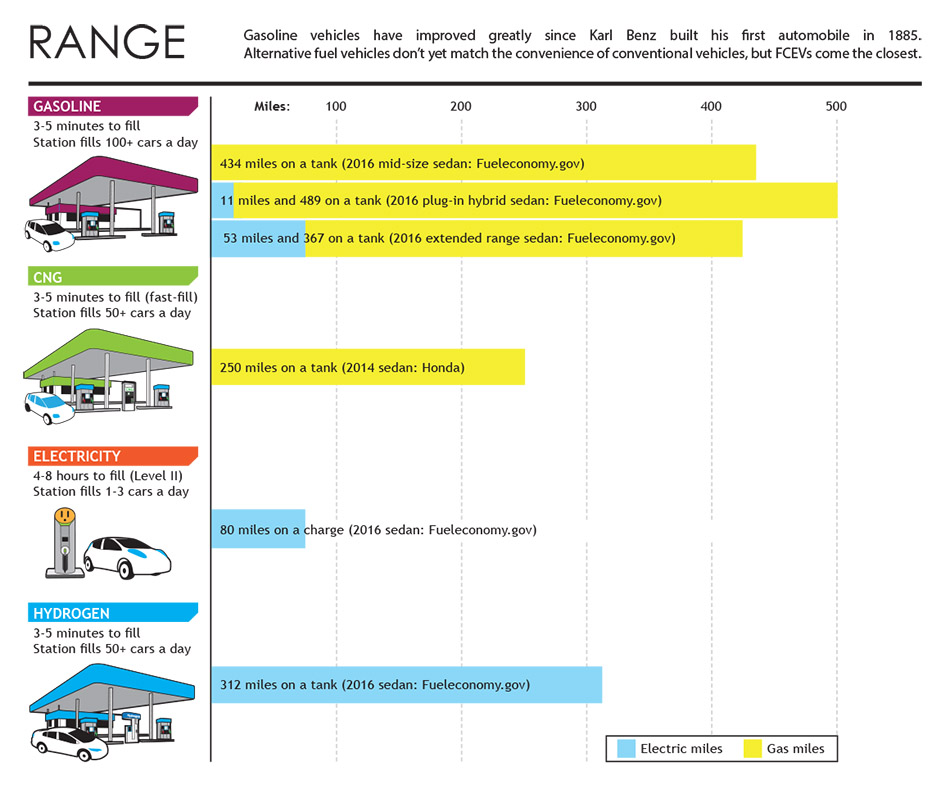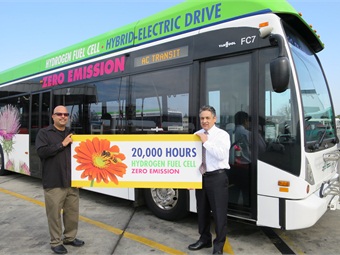Vehicles
Incentives
FCEVs are eligible for a $4,500 California rebate*




Be an eligible applicant and purchase or lease an eligible vehicle.
Apply online prior to the exhaustion of available repaid funds.
Submit copies of supporting documents.
Own and register the vehicle in CA for 30 months.
FCEVs are eligible for a California HOV sticker

Click here for application form and information
*Income eligibility requirements may apply.
Prepaid fueling from the automaker

HOW IT WORKS
A fuel cell creates electricity from a chemical reaction, not combustion. You get awesome performance, an incredible ride and a carpool sticker that tells the world you're aiming for zero (emissions, that is.)
Fuel cells create electricity from reactants stored externally. A proton exchange membrane (PEM) fuel cell uses hydrogen and oxygen as the reactants. In its simplest form, a PEM fuel cell is two electrodes—the anode and the cathode—separated by a catalyst-coated membrane. Hydrogen from the vehicle’s storage tank enters one side of the fuel cell stack and air on the other side. The hydrogen is naturally attracted to the oxygen in the air. As the hydrogen molecule moves through the stack to get to the oxygen, the catalyst forces the hydrogen to separate into electron and proton.
The proton moves through the membrane and the electron moves to the anode. The electricity flows into a power module, which distributes electricity to the electric motor that turns the wheels of the car. The power module also distributes electricity to the air conditioning, sound system and other on-board devices.
At the cathode, the electron recombines with the proton, and the hydrogen joins with the oxygen to create the vehicle’s only tailpipe emission—water. Fuel cells produce electricity as long as fuel is supplied.
VEHICLE SAFETY
From bumper to bumper, FCEVs are designed with safety in mind. Engineering, equipment, and safety codes and standards are designed for hydrogen and fuel cells. What you see, though, is a great vehicle for you and your family.
FCEVs are as safe as any vehicle on the road. HFCP vehicle manufacturer members subject fuel cell electric vehicle models to extensive safety testing prior to releasing them on public roads. Current testing employs both destructive and non-destructive evaluations and occurs at the component, system, and vehicle level.
The on-board hydrogen storage tanks are extremely strong, carbon-fiber wrapped tanks. Similar to CNG tanks, hydrogen tanks are put through a battery of extreme tests, including bonfire, pressure cycling, impact, burst and penetration tests. The cylinders must meet strict manufacturer guidelines and are being tested to an international standard, the GTR 13. This will ultimately be the US DOT's hydrogen fuel cell vehicle safety standard.
Hydrogen is colorless, odorless and non-toxic. Other fuels either have odor (gasoline) or are odorized (natural gas) and leaks are detected by smell. Hydrogen is not odorized due in part to its small molecular weight and buoyancy, and because an odorant would contaminate hydrogen purity and affect vehicle performance. Leaks are detected by sensors.
HFCP does extensive training with fire fighters and other first responders in the communities where FCEVs and FCEBs are and will be deployed. The combination of vehicle design, safety systems and knowledgeable responders make FCEVs as safe as other vehicles on the road.
RANGE
2019 Gasoline four-door sedan – 444 miles
2019 FCEV four-door sedan – 360 miles
2019 BEV four-door sedan – 150 miles
*Number of miles from a full tank of fuel or charge (x/444 miles) | https://www.fueleconomy.gov/feg/fcv_sbs.shtml
You can go a long way on a small amount of hydrogen. Fuel cells are 2-3 times more efficient than combustion engines, and making hydrogen is an energy efficient chemical process. You'll drive as far as you drive today on about 1/3 as much fuel. It's better living through chemistry.
Energy efficiency is important, but not the whole picture. Fuel economy—“miles per gallon”—is a result of engine (or motor) efficiency, size, weight, road conditions and driving style. A bus and a car could both have a fuel cell that operates at 60% efficiency, but because the bus is heavier and stops and starts often, it will have a lower fuel economy than the car.
WHAT CUSTOMERS SAY
"What drives me to do what I do is thinking about future generations. Our children and our children's children are gonna be faced with a world that's very different."
Angela
Toyota Mirai Driver
10 Facts about FCEVs

Automakers include three years of hydrogen fuel with the sale or lease of a vehicle
Cost to refill
The average price of hydrogen for a light-duty fuel cell electric vehicle (passenger car) in California is $16.51 per kilogram, according to the 2019 Joint Agency Report (p17). As more retail stations open and have higher utilization, the price per kilogram of hydrogen is projected to drop to ranges more competitive with the prices of gasoline. For example, in late 2019, the True Zero Oakland hydrogen station opened with three times the capacity of previous stations. It offers hydrogen at $13.11 per kilogram (tax included) due, in part, to the larger volume and other factors.
In addition, drivers of fuel cell electric cars are offered free fuel by automakers for three years, to bridge the time it takes the market to become more competitive with other fuel options.
Reports, studies, and white papers from the Hydrogen Council, NREL and Shell, among others, all point to reductions in the price of fuel and fueling infrastructure for various reasons (scaling up, standardization, etc.).
Hydrogen Council: Path to Hydrogen Competitiveness: A Cost Perspective
Shell: Hydrogen Refueling Station Cost Reduction Roadmap
Shell: Towards Competitive Refueling Infrastructure
NREL: Manufacturing competitiveness analysis for hydrogen refueling stations
BloombergNEF: Hydrogen Economy Outlook Key Messages
Please note: The information above pertains to hydrogen stations serving light-duty fuel cell electric vehicles (passenger cars) and, therefore, does not reflect the cost or price of hydrogen for buses, trucks or any other fuel cell electric vehicle category.

Zero tailpipe emissions—just a little water vapor
Emissions

Fuel cell electric vehicles (FCEVs) are zero-emission vehicles and every method of producing hydrogen results in almost no air pollutants. On California’s Smog Scorecard for new vehicles, FCEVs rate a 10—the cleanest.


As safe as any other vehicle on the road—some say even safer
Safety

Fuel cells are designed to last the lifetime of the vehicle
Durability
Durability is a key performance factor and the U.S. Department of Energy durability target for transportation fuel cells is 5,000 hours under realistic operating conditions—meaning impurities in the fuel and air, starting and stopping, freezing and thawing, and humidity and load cycles that result in stresses on the chemical and mechanical stability of the fuel cell system materials and components. AC Transit already pounded this target by operating a fuel cell for over 25,000* hours in a transit bus.
*Originally 20,000 hours in 2015.

Vehicle can operate in sub-zero temperatures and desert conditions…and everywhere in between
Extreme heat and cold
Fuel cells stay damp, like a sponge, and could become damaged if the water turned to ice. In the early 2000s—during CaFCP's early years—automakers addressed the issue of "starting a very cold car not once or twice, but 2,000 times." At the same time, SunLine Transit and automakers were testing fuel cells in the extreme heat of California and Arizona deserts. But can a FCEV help its passengers survive the desert?

$4,500 California rebate*
Refill Time
Administered by the Center for Sustainable Energy for the California Air Resources Board, the Clean Vehicle Rebate Project (CVRP) offers $4,500 (up to $7,000 based on income) in electric vehicle rebates for the purchase or lease of new FCEVs.
https://cleanvehiclerebate.org/eng
*As of December 3, 2019, individual and business applicants are eligible to receive one CVRP rebate for the life of the program either via direct purchase and/or lease.

Electric motor and drive train—quiet, smooth and powerful
Electric
How are a battery and a fuel cell different? A fuel cell has an anode, a cathode and a membrane coated with a catalyst. The membrane is the electrolyte. The reactants (hydrogen and oxygen) are stored externally. Hydrogen enters the anode side of the fuel cell and oxygen enters from the cathode side. When the hydrogen molecules come into contact with the catalyst, a chemical reaction converts the energy stored in the hydrogen into an electric current. A fuel cell will create a current as long as it has fuel. When the fuel supply is shut off, the reaction stops and therefore, so does the current.
A battery has an anode, a cathode and an electrolyte that allows a chemical reaction to occur. The reactants are inside the battery. When the battery operates, a chemical reaction releases electrons through an external circuit, providing a current. Some types of batteries can be recharged, which reverses the chemical reaction and allows energy to be stored again in the battery.

Travel single in the carpool lane
HOV Sticker
How are a battery and a fuel cell different? A fuel cell has an anode, a cathode and a membrane coated with a catalyst. The membrane is the electrolyte. The reactants (hydrogen and oxygen) are stored externally. Hydrogen enters the anode side of the fuel cell and oxygen enters from the cathode side. When the hydrogen molecules come into contact with the catalyst, a chemical reaction converts the energy stored in the hydrogen into an electric current. A fuel cell will create a current as long as it has fuel. When the fuel supply is shut off, the reaction stops and therefore, so does the current.
A battery has an anode, a cathode and an electrolyte that allows a chemical reaction to occur. The reactants are inside the battery. When the battery operates, a chemical reaction releases electrons through an external circuit, providing a current. Some types of batteries can be recharged, which reverses the chemical reaction and allows energy to be stored again in the battery.

About 3-to-5 minutes to fill the tank
Refill time
The National Renewable Energy Lab has been collecting data about FCEV fueling since 2011. Of nearly 20,000 fueling events, 50% have taken less than five minutes, and 20% have taken less than three minutes. Impressive numbers considering that many of these fills were on early "demonstration" stations.
http://www.hydrogen.energy.gov/pdfs/review15/tv017_sprik_2015_o.pdf

